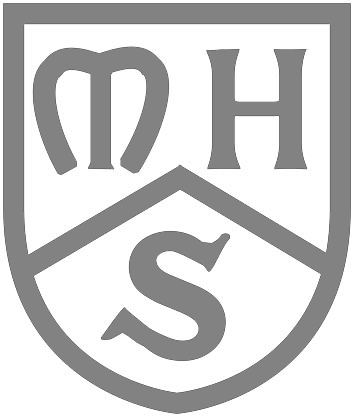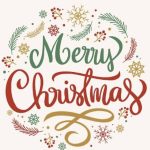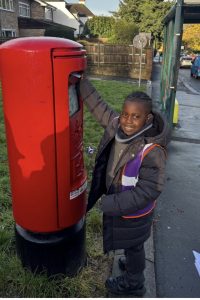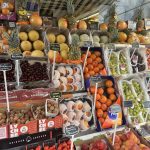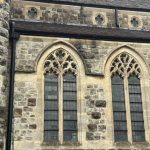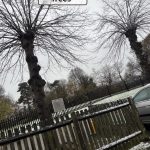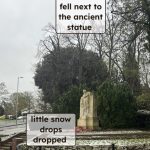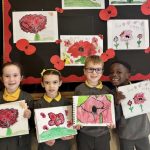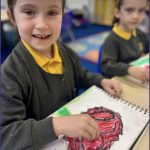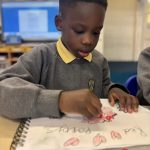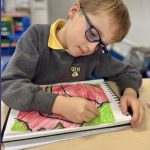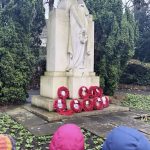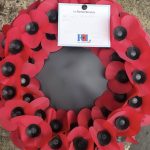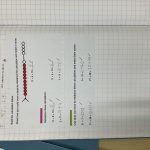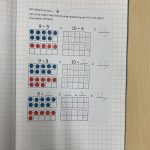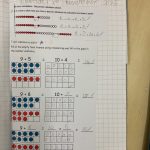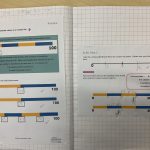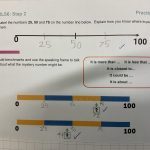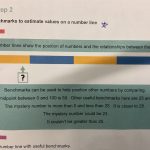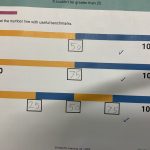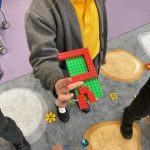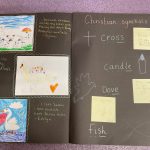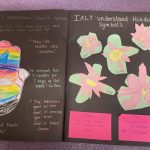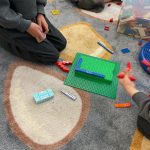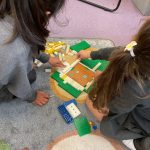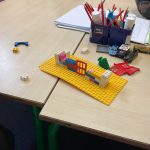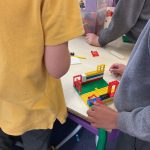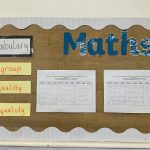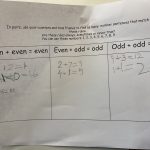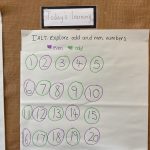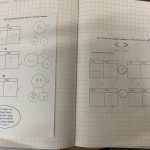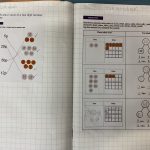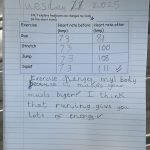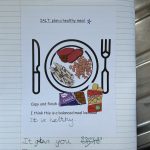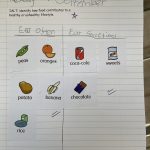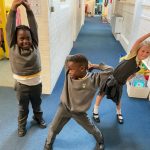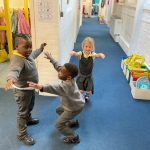Dec 182025
Thank You, Year 2! 🌟
What a fantastic autumn term it has been in Year 2! We are so proud of all the hard work, enthusiasm, and positive attitudes the children have shown over the last few months.
This term, the children have completed three wonderful stories, written creative poems, and even sent a letter home to parents using the post box, which was very exciting! We also enjoyed a walk around Bushey, taking in our local area and learning together outside the classroom.
In school, the children have worked hard to learn and follow our new school rules: Ready, Respectful, and Safe. In maths, they tackled some tricky calculations, showing great resilience while learning how to solve problems by rebalancing. In science, we have explored different materials, and in PE, the children have developed their skills and confidence through gymnastics.
Our festive period was full of joy and creativity. The children put on a lovely singing show, proudly shared their books with parents, and carefully made calendars and cards as special gifts for their families.
A huge thank you to all parents and carers for your continued support—it truly makes a difference and helps the children thrive.
Everyone now deserves a restful and well-earned break. We wish you all a happy holiday season and a brilliant New Year. We look forward to welcoming the children back on January 5th.
- Screenshot
See you next year! 🎉✨
Dec 112025
📮 Year 2s Post a Letter!
ChatGPT sIn English this week, our Year 2 children have been diving into the wonderful book Dragon Post by Emma Yarlett. Inspired by the story, we explored what makes a great letter and even had a go at writing one ourselves!
Nov 272025
Clever Coders
Young Coders in Action! 🌟 (more…)
Nov 202025
Finding Beauty in the Everyday: Our Week With Last Stop on Market Street
This week in English, we have been exploring the wonderful story Last Stop on Market Street by Matt de la Peña. The book follows a young boy on a journey with his Nana, who teaches him to notice the beauty in ordinary moments by using all of his senses. Inspired by their adventure, we set out on our own journey of discovery.
We began by listening to different pieces of music, sketching the feelings and images that came to mind. From swirling colours to calm landscapes, the children created expressive illustrations and then transformed them into vivid descriptive sentences.
On a snowy Wednesday morning, we continued our exploration with a walk up the local high street to Andrew’s fruit and vegetable shop. Along the way, we searched for local landmarks and practised using rich adjectives to describe the unexpected beauty around us. The children’s imaginations were wonderful. Some noticed trees that “looked like skeletons’ legs,” while others pointed out “beautiful, bright poppies covered in sparkly white snow.”
It was a week full of creativity, curiosity, and learning to see the world a little differently just like Nana teaches in the story.
- Screenshot
- Screenshot
- Screenshot
- Screenshot
Nov 122025
Remembrance Day!
Today, our school came together to honour and remember all those who have served and continue to serve in the Armed Forces.
In class, we used oil pastels to create beautiful poppy artwork, thinking carefully about what the poppy represents — hope, peace, and remembrance. The bright red petals reminded us of the courage and sacrifice of those who fought for our freedom.
- Screenshot
- Screenshot
- Screenshot
- Screenshot
- Screenshot
- Screenshot
We also had a very special assembly with soldiers from the Royal Air Force and Army, who shared their experiences and helped us understand the importance of Remembrance Day. They spoke about bravery, teamwork, and why we wear our poppies with pride.
After this, Year 2 walked down to the war memorial statue to pay their respects. They laid a wreath on behalf of the whole school, standing quietly to reflect on the lives lost in wars past and present. It was a thoughtful and moving moment for everyone.
- Screenshot
- Screenshot
What can you do at home?
-
Create your own poppy – Use paper, fabric, or craft materials to make a poppy and display it in your window.
-
Share a story – Talk with a family member about someone they know who served in the Armed Forces, or look up a local war hero together.
“At the going down of the sun and in the morning, we will remember them.” 🌹
Nov 062025
Rebalancing to add 9 and 11
Oct 232025
Benchmarking 0-100
This week, we explored benchmarking numbers from 0–100 — and wow, it was trickier than we first thought! At first, it felt a little confusing to think about where numbers should go on a number line without any help. But by taking small, steady steps, we built our understanding and confidence.
We began by working with a number line that showed all the tens — 0, 10, 20, 30, and so on up to 100. This helped us see the pattern and spacing between each group of ten.
Next, we challenged ourselves by taking away most of those numbers and only keeping the benchmarks 25, 50, and 75. Using what we already knew about the number line, we practiced estimating where other numbers would fit between those key points.
To make it more fun (and a little competitive!), we rolled two dice — one for the tens and one for the ones — to make a two-digit number. Then we had to place our number where we thought it belonged on the number line. This helped us develop our estimation and reasoning skills.
Finally, we faced the ultimate test: a blank number line! Using our understanding of quartiles and midpoints, we marked out 25, 50, and 75, then added in our tens using estimation. It was great to see how our confidence grew from needing lots of support to being able to place numbers independently.
Top 3 Tips to Try at Home
-
🎲 Roll and Place: Roll two dice to make a two-digit number and challenge your child to show roughly where it belongs on a blank line from 0–100.
-
🧮 Number Talk: Pick any number and ask, “Is it closer to 0, 50, or 100?” Talking through the reasoning helps build number sense.
-
🏠 Everyday Estimation: When you see numbers at home (like prices, page numbers, or house numbers), ask, “What two tens is it between?” or “Where would that go on our number line?”
-
Oct 162025
How to Look After a Ghost – And Be a Good Friend Too!
This week in class, we had lots of fun exploring a spooky but sweet story called How to Look After a Ghost by Rebecca Green. This magical book helped us learn something surprising: ghosts aren’t scary at all but instead they can actually be our friends!
Giving Commands with Bossy Verbs
Before we read the story, we practised giving commands using bossy verbs. We took part in some fun role play where we gave instructions to our friends like:
-
“Pick up the pencil!”
-
“Sit down quickly!”
-
“Open your book!”
Bossy verbs help us tell someone what to do clearly and confidently and they are perfect for writing instructions!
What We Learned from the Story
Once we read How to Look After a Ghost, we discovered lots of things about ghosts, such as:
👻 Ghosts are our friends!
📚 They love reading spooky stories.
🍽️ They enjoy eating Monster Mash (yum!).
🏠 And the best way to welcome a ghost into your home? Blow gently to say hello!We explored the book together and talked about what we’d do if a ghost came to stay in our house. Then, we wrote our own set of instructions using bossy verbs. Some of us even had creative ideas like:
-
“Tuck your ghost in at night.”
-
“Make your ghost a cup of slime-tea.”
-
“Tell your ghost a bedtime story.”
We made sure to use conjunctions like and, because, and so to join our ideas. For example:
“Feed your ghost a midnight snack because ghosts get hungry at night!”
How to Be a Good Friend
This week, we are also learning how to be a good friend. We shared ideas and gave each other kind commands, such as:
-
“Share your toys.”
-
“Listen when your friend is talking.”
-
“Say sorry if you hurt someone.”
We even made freeze frames to act out different ways to show friendship such as; helping someone up when they fall or inviting someone to play.
Try These at Home!
Here are 3 things you can try at home to practise being a good friend:
-
Write a kind note to someone in your family or a friend.
-
Write a set of instructions about something that is important to you.
-
Play the unfortunately game in partners where one of you starts your sentence with a positive clause, then you add the unfortunately by using the conjunction but. For example “ I arrived at school but I then saw a monster!”
Remember, being a good friend means using kind words, sharing, and always looking out for others—just like how we look after our ghost friends too!
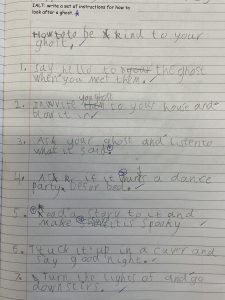
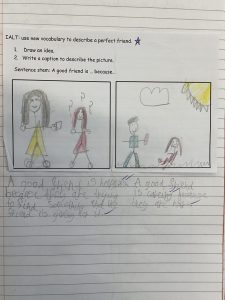
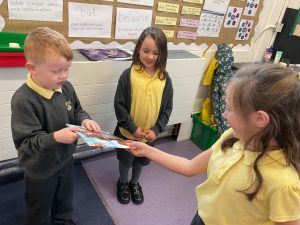
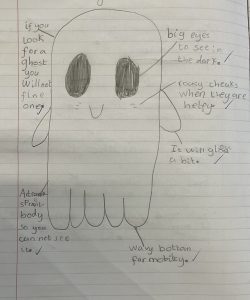
-
Oct 092025
Religious Symbols
Learning About Religious Symbols in RE!
This week in RE, we’ve been exploring the rich and diverse world of religious symbols from four major world religions: Christianity, Hinduism, Islam, and Judaism.
We’ve had lots of fun getting creative while deepening our understanding of what these symbols mean to different faiths:
We made Hamsas and beautiful Lotus Flowers to celebrate the importance of symbols in Hinduism and Judaism.
Today, we built Mosques, Stars and Crescents, and Dome structures out of LEGO to represent important symbols in Islam.
Throughout all our activities, we’ve been learning how these symbols reflect the beliefs, values, and traditions of each religion.
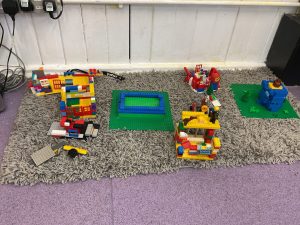
Our final products
3 Things to Try at Home:-
Symbol Scavenger Hunt – Look for religious symbols in books, decorations, or places of worship near your home or online. Can you identify them?
-
Create Your Own Symbol – Design a symbol that represents something important to you or your family. What shapes, colours or patterns would you use?
-
Story Time – Find and read a story from one of the religions we’ve studied. What symbols appear in the story, and what do they mean?
-
Oct 022025
Maths Fun in the Classroom!
Maths Fun in the Classroom!
In our recent maths lessons, we’ve been exploring place value using tens and ones. The children have been learning how to regroup numbers, discovering that 10 ones can be exchanged for 1 ten and that it works the other way around too! This concept has even been extended to money, helping our children make real-world connections with their learning.
Alongside place value, we’ve also been investigating odd and even numbers. In pairs, the children carried out a fun investigation to find out what happens when you add different combinations of odd and even numbers:
-
Even + Even
-
Even + Odd
-
Odd + Odd
Some children went above and beyond, using numbers greater than 20 to challenge themselves even further!
Three Things You Can Try at Home:
-
Play “Make 10” – Gather small objects (like coins or buttons) and ask your child to group them into 10s. Can they regroup 10 ones into 1 ten? What about regrouping 1 ten into 10 ones?
-
Spot Odd and Even Numbers Around You – Look at house numbers, car number plates, or page numbers in a book. Ask your child if they are odd or even and why!
-
Money Maths – Use real coins to practise making different amounts. Can your child make 20p in different ways? What happens when they trade ten 1p coins for a 10p coin?
It’s been a brilliant start to our maths journey this term, and we’re so proud of how engaged and enthusiastic the children have been!
-
Sep 242025
Healthy eating and exercise – Science
In our recent science lessons, we’ve dived into some topics about how our bodies work, how food impacts our health, and how exercise helps keep us strong and healthy.
What We Eat: Food to Eat Sometimes vs. Food to Eat Often
Our first lesson focused on the importance of making healthy food choices. We learned about foods that we should eat often, like fruits, vegetables, and whole grains, and foods that we should eat only sometimes, such as sweets and processed snacks. Eating a balanced diet helps provide our bodies with the energy and nutrients we need to feel good and stay active.
To make sure we’re getting a balanced diet, we planned a meal with a variety of food groups. We included vegetables, protein, healthy fats, and carbohydrates—each playing a role in keeping us healthy.
Heart Health: How Exercise Affects Our Heart Rate
In our next lesson, we conducted an experiment to measure how exercise impacts our heart rate. We began by counting our resting heartbeats (how many beats our hearts make in a minute while we’re at rest). Then, we performed different exercises, like running, squatting, and stretching, and measured how each one affected our heart rate.
Here’s what we found:
-
Running and Squatting: These exercises made our heartbeats increase the most, likely because they use more muscles and require more energy.
-
Stretching: While stretching also made our heart rate go up, it was the least intense of the exercises. But interestingly, even though it was less intense, stretching still increased our heartbeats more than our resting heart rate.
We were surprised to find that for some of us, squatting caused a higher heart rate than running! This shows just how different exercises can have different effects on our bodies.
Three Things You Can Do at Home to Stay Healthy:
-
Go for a Walk or Run: Walking or running is a great way to get your heart rate up and improve your cardiovascular health. You can start with short walks and work your way up to longer runs as you feel more confident.
-
Try Squatting or Jumping Jacks: These exercises help build strength in your legs and core. You can try doing squats or jumping jacks for a few minutes each day, and you’ll start to feel stronger in no time!
-
Stretch Daily: Stretching is a gentle way to keep your muscles flexible and your heart rate up. You can stretch in the morning or before bed—just make sure to hold each stretch for 15-30 seconds to get the full benefit.
By paying attention to what we eat and how much we move, we can take charge of our health and feel our best. So, start practicing these tips at home, and watch how your body and mind grow stronger and happier every day!
-
Sep 202025
Frog and Stranger – English
Due to a technical issue we have been unable to upload photographs this week.
Over the past few weeks, we’ve been diving into the wonderful world of Frog and Stranger. This book has not only sparked our imaginations but have also helped us become stronger writers!
In class, we’ve been working hard on writing single clause sentences and then learning how to join them together using conjunctions like:
-
and – to add more information
-
but – to show something different or opposite
-
or – to offer a choice
We’ve also been practising how to self-correct our work. Before we say a sentence is finished, we always check for our non-negotiables:
-
Capital letters at the beginning
-
Full stops at the end
-
Finger spaces between words
Another important skill we’ve learned is making sure every sentence includes a who and a what – this helps us make sure our writing makes sense and tells a clear story.
🏡 3 Things You Can Do at Home
Here are three fun and simple ways to support your child’s writing at home:
-
Talk in Sentences Together
Ask your child to describe what they’re doing using full sentences. For example, instead of “playing Lego,” encourage them to say,
➤ “I am building a tower with my Lego and it is very tall.” -
Frog and Stranger Story Time
After reading a Frog and Stranger story (or any story!), ask your child to retell part of it using sentences joined with and, but, or or.
➤ “Frog wanted to help but Stranger was scared.”
➤ “They had tea and they talked about their day.” -
Check the Checklist Together
After your child writes something – even if it’s just one sentence – read it together and ask:-
Is there a capital letter?
-
Is there a full stop?
-
Are there finger spaces?
-
Who is the sentence about?
-
What are they doing?
-
-
